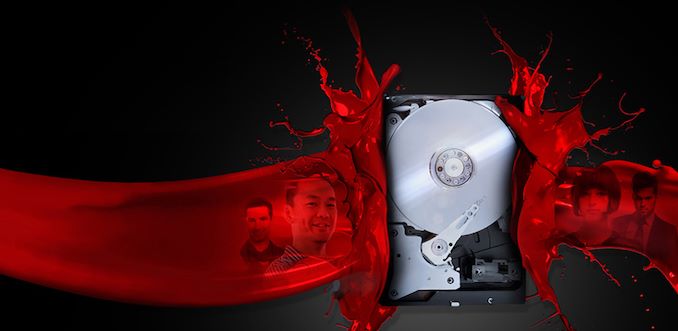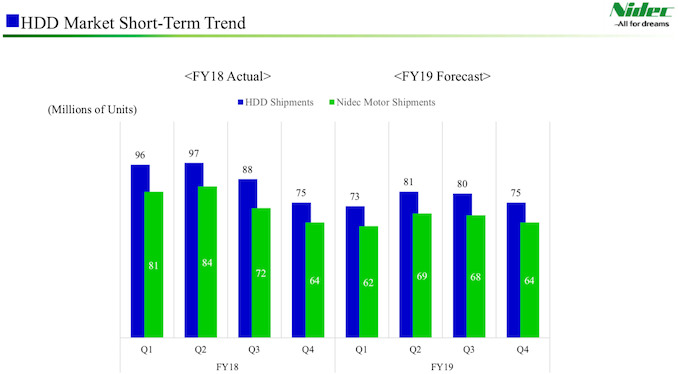Shipments of PC Hard Drives Predicted to Drop By Nearly 50% in 2019
by Anton Shilov on May 3, 2019 12:00 PM EST
According to a new financial presentation from Nidec, a Japanese motor manufacturer who is responsible for around 85% of all HDD spindle motors, the company believes that shipments of hard drives for PCs will drop significantly this year. Citing numerous ongoing trends, the motor maker is preparing for HDD motor sales to drop by around 50% year-over-year for 2019. Meanwhile the company also expects sales of other types of HDDs to slow, but not as drastically. In fact, unit shipments of hard drives for datacenters are projected to increase a bit.
According to Nidec's data, unit sales of hard drives declined by around 43% from 2010 to 2018, going from around 650 million units in 2010 to 375 million units in 2018. And it looks like sales will continue to drop in the coming years. Recently Nidec revised its HDD shipment forecast downwards from 356 million drives to 309 million drives in 2019, which will further drop to 290 million units in 2020. The recent drops in HDD shipments have already forced Nidec to optimize its HDD motor production capacities and repurpose some capacity to other types of products.
Shipments of PC HDDs have been hit the hardest among all types of HDDs due to a combination of general market weaknesses and the transition of notebooks to SSDs. According to Nidec, shipments of PC HDDs decreased gradually from 289 million drives in 2013 to 124 million devices in 2018. However, this year sales of hard drives for PCs will drop sharply, going from 124 million devices in 2018 to 65 million units in 2019, or by around 48%.
Meanwhile shipments of hard drives for broader consumer electronics devices is expected to decrease from 77 million HDDs in 2018 to 70 million in 2019. This is likely being driven by lower sales of current-generation consoles, surveillance systems, and other devices.
There is a bright spot in the HDD market however: external HDDs as well as nearline hard drives for datacenters are both looking strong. Shipments of the former will stay flat at around 100 million units, whereas sales of the datacenter drives are expected to increase to 54 million units, according to Nidec. Conversely, sales of enterprise-class drives – which Nidec counts separately from datacenter drives – are expected to decline a bit as mission-critical applications migrate to SSDs.
Amongst all of these shifts in HDD sales volumes, it is noteworthy that the leading hard drive makers have indicated that while unit sales of nearline and surveillance HDDs may stay more or less flat (or even drop), their capacities and ASPs are getting higher.
Nidec controls the lion’s share of the market for HDD spindle motors, so its projections are rather valuable and definitely worth checking out. Especially as the company expects to maintain its high market share throughout this calendar year.
Related Reading:
- Western Digital: Over Half of Data Center HDDs Will Use SMR by 2023
- Toshiba's HDD Tech Roadmap: A Mix of SMR, MAMR, TDMR, and HAMR
- Western Digital to Demo Dual-Actuator HDDs Next Week: Double the Actuators for Double the Perf
- 18 TB HDDs: Toshiba Collaborates with Showa Denko for MAMR HDDs
- HOYA Starts to Build Next-Gen HDD Glass Substrate Production Facility
- State of the Union: Seagate's HAMR Hard Drives, Dual-Actuator Mach2, and 24 TB HDDs on Track
Source: Nidec












73 Comments
View All Comments
Beaver M. - Sunday, May 5, 2019 - link
If I didnt have my movie collection, then it would have been really bad the still very numerous times when my Internet went out.Also Im not going to subscribe to 3 or 4 providers just to have everything available I want. Seeing how bad movies have become the last few years, its also not worth it anymore. I just buy the movies I want, so I dont have to pay a monthly subscription, which would be much more expensive. The only thing I regret so far is not being able to watch Netflix' Bandersnatch. But I am sure they will find a solution to watch that offline sooner or later.
So yeah, I am happy with my 12 TB HDD (actually only 10.8 TB), but probably will need more than that in a few years.
flyingpants265 - Monday, May 6, 2019 - link
Because I have 2x4TB drives, and one 2.5" 1TB drive acting as a pure backup.damianrobertjones - Thursday, May 9, 2019 - link
You are not the only person in the world. Some of use don't wish to pay a monthly subscription to service x, y and z, only to find stuff STILL not on that service. Some of us prefer to outright OWN our media instead of hiring everything.I have over 20Tb of backed-up films, music I've owned over the years, on my small server. It might be convenient for many people to stream, but that's for them.
3DoubleD - Friday, May 3, 2019 - link
It would be most interesting to see these trends compared with the amount of total storage shipped per year. This data on a per market segment basis would be even more interesting. I'm curious if the number of units is going down because the average drive size is increasing. I'd guess that this effect is strongest in the data center market, but it might be present elsewhere.DanNeely - Friday, May 3, 2019 - link
Look at the graphs and read the article first please. Data center drive shipments are going up. The shrinking is primary due to consumer (PC/Laptop) HDD sales collapsing.Previous reports have shown total storage going up and HDD maker revenue fairly stable because the drives going away are low capacity low margin models; while the data center drives are both much more profitable/drive and keep going up in size.
ghostbit - Friday, May 3, 2019 - link
So will we get discounts on WD Red/Seagate IronWolf or will they fall under the "enterprise" category?DanNeely - Friday, May 3, 2019 - link
Definitely not enterprise that's SAS drives; Red/Ironwolf's small/medium size nas straddles the line between Consumer and Data Center. From the perspective of an HDD motor maker I suspect they go in the latter bucket since they need to have the same higher vibration tolerance.eastcoast_pete - Friday, May 3, 2019 - link
One of the reasons why demand for "spinning rust" drives is slumping is the cartel-like absence of real competition among HDD makers, which keeps HDD prices artificially high. Really wish the respective authorities in the US, the EU and China would take a close look at that trio! That anti-competitive situation in the HDD market will get even worse now, as the same companies (WD/HGST, Seagate and Toshiba) have build up too much solid state drive capacities, and want to move those to avoid write-downs. Don't get me wrong, I also prefer an SSD as the boot and work drive, but for larger scale cold storage of UHD video files and for backup in general, a couple of 6, 8 or 10 TB drives is still the way to go.khanikun - Monday, May 6, 2019 - link
Yep. I remember getting HGST NAS 6 TB 7200 rpm drives for around the $175 mark. WD bought them up, got rid of HGST. Now you can only find a 7200 rpm drive with their WD Red Pro, which at 6 TB is $220. Their regular Red is just 5400 rpm and that still costs $200.At least there is still Seagate. Wish Toshiba was a better competition.
flyingpants265 - Monday, May 6, 2019 - link
HDD prices used to get cut in half every couple years. Shortly after they introduced 4TB, it's like prices stopped going down.. There was also the whole factory flood which they managed to milk for years.Should have gone to 4" or higher platter sizes, stacked more platters, and used the 5.25" drive bays. We could have had 30TB drives by now. Now it's too late, a lot of self-built cases don't even have 5.25" bays.